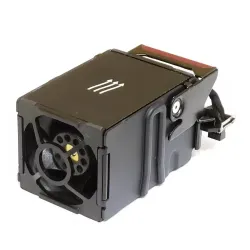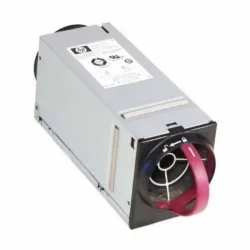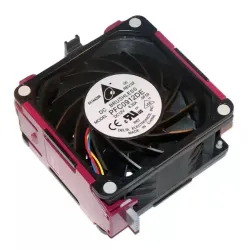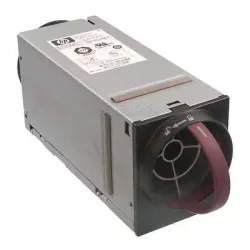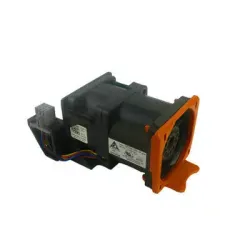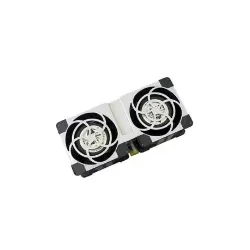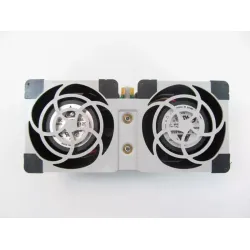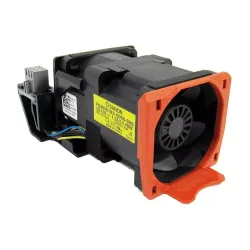The benefits of server fans
The server fan can keep the system cool
Server fans draw cool air from outside the server case into the system. The cool air is circulated across the hot server components such as the CPU, memory, and storage devices. As the air passes over the hot components, it absorbs heat and becomes warmer.
The warmer air is then expelled out of the server case by another set of fans, usually located at the back or top of the server. The cycle repeats, with the fans continually circulating cool air into the server case and expelling hot air out. By constantly circulating cool air and expelling the hot air, server fans keep the system cool and prevent overheating. This is important because overheating can cause damage to the server components, leading to system failure and downtime. Server fans are typically designed to run continuously to ensure consistent cooling, and their speed can be adjusted based on the temperature of the components to optimize cooling efficiency.
server fan Improved Performance of the system
Many server components are designed to throttle or reduce their performance automatically when they reach a certain temperature to prevent damage. With proper cooling from server fans, these components can operate at their full potential without being throttled.
Overheating can cause permanent damage to server components, leading to system downtime and data loss. With server fans in place, the risk of hardware failure is reduced, improving the overall reliability of the system. A reliable system with properly functioning components is likely to perform better than a system that is prone to hardware failure. Server fans are designed to optimize cooling efficiency by adjusting their speed based on the temperature of the components. This ensures that the server components are cooled effectively, without wasting energy on cooling components that are already cool.
Reliability of server fan
Quality of Components: The quality of the materials and components used in server fans can have a significant impact on their reliability. High-quality components are more likely to function reliably over the long term than low-quality components.
Design and Manufacturing Quality: The design and manufacturing quality of server fans can also impact their reliability. Fans that are designed and manufactured with care are less likely to experience problems like mechanical failures and are more likely to operate consistently and quietly. Maintenance: Regular maintenance of server fans is essential to their reliability. Over time, dust and debris can accumulate on the fan blades, which can reduce the efficiency of the fan and cause it to operate less reliably. Regular cleaning and maintenance can help to prevent these issues and ensure that the fan continues to operate at peak performance.
Server fans can improve energy efficiency
Preventing Overheating: By keeping server components cool, server fans prevent overheating, which can cause the system to consume more energy than necessary. Overheating can cause components to operate less efficiently and can cause them to require more power to operate at their full potential.
Reducing System Downtime: When a server component fails due to overheating, the system may be down for an extended period. During this time, the system continues to consume energy even though it is not providing any useful work. By keeping components cool and preventing failures due to overheating, server fans can help to reduce system downtime and, as a result, energy consumption. Optimizing Fan Speed: Modern server fans are designed to adjust their speed based on the temperature of the components. By adjusting the fan speed to match the cooling needs of the components, the server fan can operate at the lowest speed necessary to maintain the desired temperature. This can help to reduce energy consumption by ensuring that the fan operates at the lowest speed possible while still providing sufficient cooling.
Log in to the iLO interface using your web browser. To do this, enter the iLO IP address into your web browser's address bar. Enter your iLO credentials to log in. Once you have logged in, you should see the iLO Dashboard. From here, click on the "Health" tab. In the Health tab, you can see the status of all the hardware components in your server, including the fans. If a fan has failed or is not working properly, it will be indicated with a warning or error message.
Identify the fan that needs to be replaced. You can typically do this by checking the server's hardware logs or using server management software to monitor the fan's status. Shut down the server and unplug it from the power source. Locate the fan that needs to be replaced. The fan is typically located in the front or rear of the server, depending on the server model. Remove the fan from its slot by gently pressing the release latch or pulling it out of its bracket, depending on the server model.
Turn off your computer and unplug it from the power source. Open the computer case to access the fan. The fan is typically located near the processor on the motherboard. Use compressed air to blow out any dust or debris that has accumulated on the fan blades and heatsink. Hold the can of compressed air upright and use short bursts of air to blow away any dust or debris. If the fan blades are still dirty, you can use a soft-bristled brush, such as a toothbrush, to gently scrub away any remaining dust or debris.
Power off your computer and unplug it from the power source. Use a can of compressed air to blow out any dust or debris from the fan blades and heatsink. Hold the can of compressed air upright and use short bursts of air to blow away any dust or debris. Use a soft-bristled brush, such as a toothbrush, to gently scrub the fan blades and heatsink to remove any remaining dust or debris. If there is still visible dirt or dust on the fan blades and heatsink, you can use a lint-free cloth dampened with isopropyl alcohol to gently wipe them clean.

